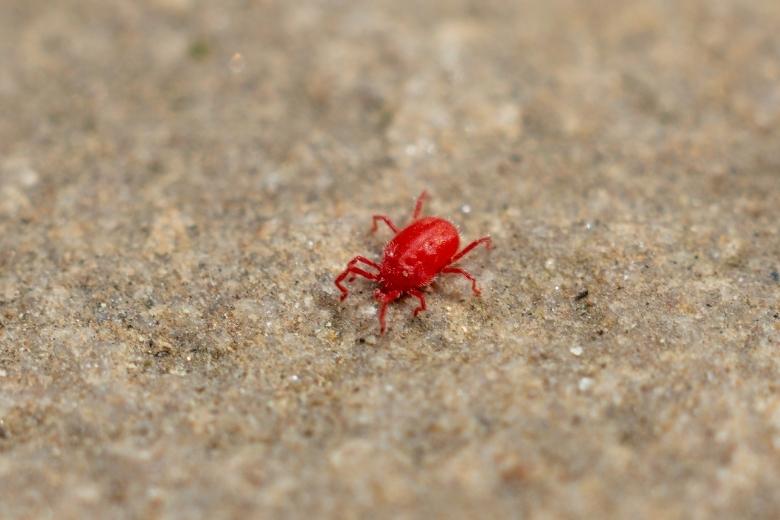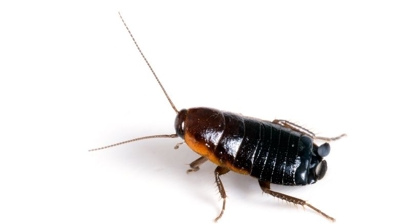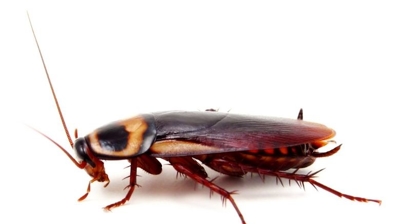
Concrete Mite Control Services

Concrete Mites
Concrete mites (Balaustium spp.) are generally not considered harmful in most contexts, but there are a few situations where they might be problematic:
- Nuisance Pests – These mites often appear in large numbers on patios, sidewalks, driveways, and other concrete surfaces, which can be unsightly and bothersome. Their red coloration and fast movement may alarm homeowners.
- Potential for Staining – When crushed, concrete mites can leave red stains on surfaces such as patios, walls, outdoor furniture, and clothing. This can be frustrating for homeowners trying to maintain a clean outdoor space.
- Minor Skin Irritations – While not known to bite humans, some people report mild skin irritation after handling these mites. This could be due to their body fluids, which may contain allergens or mild irritants.
- Impact on Plants – Some species of Balaustium mites feed on pollen, algae, and decaying organic matter, but in large numbers, they may also damage young plants by feeding on their tender tissues. However, they are not major agricultural pests.
- Confusion with Other Harmful Mites – Their resemblance to other red mites, such as clover mites (Bryobia spp.) or chigger larvae (Trombiculidae), can cause unnecessary concern. Unlike chiggers, concrete mites do not bite humans or pets, but their presence may still lead to misidentification and unwarranted pesticide use.
While they do not pose serious threats to human health, pets, or structures, their presence in large numbers can be frustrating. Control measures are usually unnecessary unless their population becomes excessive, in which case reducing moisture, cleaning outdoor surfaces, and sealing entry points can help manage their numbers.
Learn more: Do Concrete Mites Bite?
Clover Mite Removal
Getting rid of concrete mites is crucial because these tiny pests can have significant and sometimes overlooked impacts on health, property, and comfort. Concrete mites thrive in environments like cracks, damp areas, and under concrete slabs, where organic debris accumulates. Here’s why controlling them is important:
Health Risks
- Allergic Reactions: Concrete mites produce waste, shed body parts, and secretions that can trigger allergic reactions. Symptoms may include sneezing, nasal congestion, itchy eyes, and skin rashes.
- Asthma and Respiratory Issues: For people with asthma or other respiratory conditions, exposure to mite allergens can exacerbate symptoms, leading to attacks or chronic irritation.
- Skin Irritation: Some concrete mites can bite or irritate skin, causing redness, swelling, or itching. In sensitive individuals, these reactions can be severe and persistent.
Structural and Property Concerns
- Accumulation of Organic Material: Concrete mites thrive in cracks, gaps, or under slabs where dust, soil, and organic matter collect. Over time, this can accelerate degradation of surfaces.
- Secondary Infestations: Areas with concrete mites often attract other pests, such as ants or beetles, creating compounded infestation problems.
- Moisture Issues: Their presence is often a sign of damp or poorly ventilated areas. If not addressed, these conditions can lead to mold growth, which is a bigger structural and health concern.
Economic and Comfort Impacts
- Treatment Costs: If left unchecked, infestations can spread, making treatment more difficult and expensive. Early intervention is far cheaper and less disruptive.
- Reduced Quality of Living: Continuous exposure to mites can make homes uncomfortable and unhealthy. It can impact sleep quality, indoor air quality, and overall comfort.
- Property Value: Persistent infestations or signs of structural moisture problems can reduce the resale value of property.
Challenges in Eradication
Concrete mites reproduce rapidly and can survive in small, hard-to-reach cracks. Failure to address them promptly often means infestations become widespread, requiring intensive professional intervention.
Getting rid of concrete mites isn’t just about pest control—it’s about preventing health risks, protecting property, reducing costs, and maintaining a safe, comfortable environment. For long-term control, the solution usually involves identifying moisture sources, sealing cracks, removing debris, and sometimes professional-grade treatments.
Learn more: How To Get Rid Of Concrete Mites
Concrete Mite Control
Hiring our professional pest control for concrete mites (a type of small, red mite that often invades homes and businesses, especially in spring and fall) is highly recommended because of the unique challenges they present:
- Identification Accuracy: Concrete mites can easily be confused with other tiny pests like clover mites, spider mites, or dust mites. Our professionals are trained to accurately identify the species. Proper identification is crucial because treatment methods differ between mite species.
- Effective Treatment Solutions: Concrete mites can infest both the exterior (lawns, sidewalks, foundations) and interior (windowsills, walls) of buildings. Over-the-counter sprays often fail to reach the areas where mites thrive. Our professionals use specialized, targeted treatments that penetrate cracks, crevices, and foundations, ensuring more thorough eradication.
- Long-Term Prevention: Our pest control experts don’t just eliminate existing mites—we implement strategies to prevent re-infestation. This might include sealing entry points, treating surrounding vegetation, and applying residual insecticides around the building perimeter.
- Health and Safety Considerations: Some mite treatments involve chemicals that can be hazardous if applied incorrectly. Our professionals know the appropriate products, concentrations, and safety measures to protect occupants, pets, and the environment.
- Time and Stress Savings: Trying to manage a concrete mite infestation on your own can be frustrating and time-consuming. Our professionals handle the problem efficiently, reducing the likelihood of repeated treatments and prolonged infestation.
- Inspection and Monitoring Expertise: Our professionals can inspect areas you might overlook, such as cracks in concrete, window frames, or areas with vegetation close to the building. We also provide monitoring services to catch infestations early, which is particularly important since concrete mites reproduce rapidly under favorable conditions.
- Cost Efficiency in the Long Run: While DIY treatments might seem cheaper initially, repeated failed attempts and ongoing infestations can become more costly. Our professional services resolve the issue more quickly and effectively, preventing damage and reducing recurring expenses.
Concrete mites are persistent, tiny pests that require precise identification and treatment. Our professionals bring the expertise, equipment, and strategies to not only eliminate them but also prevent future infestations, keeping your home or business safe, clean, and stress-free.
Concrete Mite Exterminators
Hiring our local exterminators rather than a national pest control company for concrete mites comes with several distinct advantages, particularly because these pests require a precise, site-specific approach:
Local Knowledge of Pest Behavior
- Species Variation: Concrete mites are not uniform across regions; different climates, soils, and building practices host slightly different mite populations. Our local exterminators understand which species are most common in your area and their specific habits.
- Environmental Factors: Our local professionals are familiar with seasonal activity patterns, humidity levels, and how local construction materials affect mite infestations. This allows for targeted treatment rather than a “one-size-fits-all” approach.
Customized Treatment Plans
- Property-Specific Strategies: National companies often rely on standardized protocols. Our local exterminators inspect the property, identify exact sources (cracks, moisture zones, debris under slabs), and create a tailored treatment plan that addresses both the mites and the conditions that allow them to thrive.
- Precision Application: Concrete mites hide in tiny, hard-to-reach places. Our local pros use treatments suited to the structure of your property, minimizing chemical use while maximizing efficacy.
Faster Response and Ongoing Support
- Rapid Deployment: Our local exterminators respond quickly to infestations, which is critical with concrete mites due to their rapid reproduction. National companies often take longer due to scheduling centralized teams.
- Follow-Up Services: Concrete mites are notoriously persistent. Our local team provides ongoing monitoring and maintenance visits to prevent re-infestation, whereas national chains offer less personalized follow-up.
Deep Understanding of Local Building Practices
- Construction-Specific Issues: Mites often exploit certain construction features—like concrete slabs with micro-cracks, poor drainage, or gaps around foundations. Our local exterminators are familiar with the common building methods in your area and know where to inspect and treat.
- Effective Prevention Advice: Beyond killing existing mites, our local pros can advise on site-specific preventive measures, such as moisture control, grading adjustments, or sealant recommendations.
Cost-Effectiveness and Accountability
- Tailored Pricing: Our local exterminators can provide precise quotes based on the actual infestation rather than standardized national pricing plans.
- Direct Accountability: If the treatment fails or further issues arise, you can speak directly with the technician responsible, rather than navigating corporate customer service channels.
Eco- and Health-Conscious Options
Our local professionals are often more aware of environmentally safe or low-toxicity treatments suited for the homes in the region, helping minimize chemical exposure while effectively targeting mites.
For concrete mites specifically, the advantage of our local exterminators lies in our knowledge of local mite species, building practices, and environmental factors, along with faster, tailored, and more accountable service. The nuances of concrete mite infestations often demand a hyper-local, customized approach for effective and lasting control.
What Do Concrete Mites Look Like?
Concrete mites, scientifically known as Balaustium spp., exhibit distinctive characteristics that set them apart in terms of appearance. Here is a general description of what concrete mites look like:
- Size: Concrete mites are tiny arachnids, with adults typically measuring between 0.5 to 1.5 millimeters in length. Their small size makes them challenging to spot without magnification.
- Shape: They have a round to oval body shape, which is somewhat flattened. This shape allows them to maneuver through the substrate in their terrestrial habitats.
- Color: One of the most notable features of concrete mites is their bright red to orange coloration. This vivid coloration is often described as red or orange velvet-like, which gives them their common name "red velvet mites" or "concrete mites."
- Texture: The surface of concrete mites is covered in a soft, pubescent cuticle, which gives them a velvety appearance. This velvety texture is another distinguishing characteristic.
- Legs: Concrete mites have eight legs, which is a characteristic feature of arachnids. These legs are relatively short compared to some other mite species.
- Mouthparts: They possess specialized mouthparts adapted for piercing and consuming their prey, which typically consists of small arthropods like springtails, nematodes, and other mites.
Concrete mites are minute arachnids with a round to oval body shape, bright red to orange coloration, and a distinctive velvety texture. They have eight legs and specialized mouthparts for predation. Their small size and vibrant coloration make them unique and easily distinguishable within their terrestrial habitats.
Where Are Concrete Mites Found?
Concrete mites (Balaustium spp.) are most commonly found in warm, sunny environments and tend to thrive in outdoor areas with ample dry surfaces. Here are the specific locations where you are most likely to encounter them:
- Concrete and Masonry Surfaces – They are often seen crawling on patios, sidewalks, driveways, foundations, retaining walls, and bricks, especially during warm weather.
- Around Homes and Buildings – These mites tend to gather on sunny sides of buildings, particularly near windowsills, exterior walls, and doors. They may also be found on wooden decks and outdoor furniture.
- Gardens and Landscaped Areas – While they primarily inhabit hard surfaces, they can also be found in gardens, flower beds, and mulch, where they feed on pollen, algae, and decaying plant material.
- Parks and Recreational Areas – Sidewalks, stone benches, playgrounds, and other outdoor public spaces with concrete or masonry surfaces can harbor concrete mites.
- Dry, Open Spaces – Parking lots, stadium bleachers, and other paved areas may support populations of these mites, particularly in warm climates.
They are most active during the spring and summer, especially on hot, sunny days. Their presence is often more noticeable after rainfall, as moisture encourages algae and organic debris growth, which serves as a food source for these mites.
What Do Concrete Mites Eat?
Concrete mites (Balaustium spp.) have a varied diet and primarily feed on:
- Algae and Fungal Spores – These mites consume algae and fungi that grow on concrete, bricks, and other outdoor surfaces, which is why they are often found in areas with moisture and organic buildup.
- Pollen – They are known to feed on airborne pollen, which can accumulate on outdoor surfaces, flowers, and plants. This makes them beneficial in some cases as they help reduce excess pollen levels.
- Decaying Organic Matter – Concrete mites scavenge on decomposing plant material, including fallen leaves, dead grass, and other organic debris, contributing to natural decomposition processes.
- Small Insects and Mite Eggs – Some species of Balaustium mites are predatory and may feed on other tiny arthropods, including insect eggs, smaller mites, and soft-bodied pests. This can make them beneficial in controlling certain pest populations.
While they are mostly harmless, their feeding habits sometimes lead them to gather in large numbers in certain areas, making them a nuisance rather than a direct threat.
Concrete Mite Life Cycle
The life cycle of concrete mites (Balaustium spp.) follows a typical acarid (mite) development pattern, consisting of several stages:
- Egg Stage: Female concrete mites lay tiny, spherical eggs in cracks, crevices, or protected areas on concrete, rocks, soil, or vegetation. Eggs hatch when conditions are warm and humid, usually in spring or summer.
- Larval Stage: Upon hatching, the mite enters the larval stage, which has only six legs instead of eight. Larvae are highly active and begin feeding immediately, consuming pollen, algae, and organic debris. Unlike chigger larvae (which are parasitic), concrete mite larvae are free-living and do not bite humans or animals.
- Nymphal Stages (Protonymph, Deutonymph): After molting from the larval stage, the mite enters the nymphal phase, where it now has eight legs like an adult. Nymphs continue to grow, feed, and molt through additional stages before becoming adults. Some species of Balaustium mites may show predatory behavior during this stage, preying on small insects and mite eggs.
- Adult Stage: Fully grown adults are bright red, fast-moving, and capable of reproduction. They continue feeding on pollen, fungi, algae, and small arthropods. Mating occurs, and females lay eggs in sheltered locations to continue the cycle.
- Lifespan & Activity: The entire life cycle can take a few weeks to months, depending on environmental conditions. Concrete mites are most active during warm seasons (spring and summer) and may go dormant in cooler months. They often appear in large numbers after rain, when algae and organic matter are more abundant.
While their population can fluctuate based on food availability and weather conditions, concrete mites do not typically infest homes and do not cause structural damage, making them more of a seasonal nuisance than a serious pest.

Hear From Our Happy Customers
-
"Exceeds Expectations"
I can’t say enough positive things about this company... The tech that came out, Jarvis went above and beyond my expectations. Thank you guys, I will continue using your services.
- Jake M. -
"Professional & Considerate"
I’m pleased with Miche services. Jarvis came today. Professional and considerate. Thank you!
- Judy B. -
"Wonderful Service"
Wonderful service. Jarvis is great. Took care of everything I needed. Thank you!
- Henry P. -
"Fantastic & Patient"
Jarvis was fantastic and patient. He answered my questions with an in-depth explanation and addressed all of my areas of concern. Would love for him to be my assigned tech going forward. Well done!
- Yonnette M. -
"Very Knowledgeable"
The tech that arrived was courteous, professional, and very knowledgeable. He was Great.
- Uerial I. -
"Great Communication"
Tech was on time, communication was great, and he accommodated my needs.
- Alonzo W.



